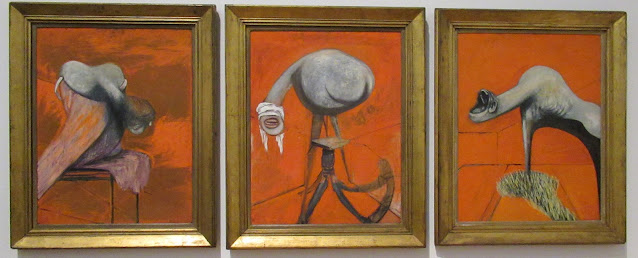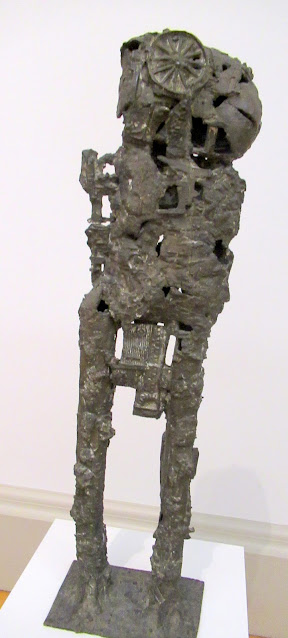We saw this exhibition a while ago and I have just managed to write it up.

After the war, Britain calls for people from the Commonwealth to help rebuild the 'motherland'. The first of the Windrush generation arrive from the Caribbean in 1948. Many are greeted with discrimination. Other people flee conflict: up to a million lose their lives in violence when Britain divides India along religious and ethnic lines ahead of independence in 1948. Artists arrive from all over the world, working, studying and teaching in Britain. Some reflect the spirit of decolonisation in their radically modern paintings and sculpture.
Franciszka Themerson, Two Pious persons Making their Way to Heaven, one propelled, one helicoptered, with a little angel below, 1951, (oil on canvas)
Wilhelmina Barns-Graham, Glacier Crystal, Grindelwald, (oil on canvas)
Elisabeth Frink, Bird, 1952, (bronze)

The Post-War era is one of immense social change and dramatic geopolitical realignment. Artists give visual expression to the experiences of loss, destruction and displacement, yet also to independence and freedom. WWII is the deadliest conflict in human history. Upwards of 85 million people die, mostly divilians. Six million European Jews are murdered by Nazi Germany, alongside other persecuted people. Colonial empires are dismantled and new superpowers - the Soviet Union and the United States - arise. They bring the threat of global nuclear annihilation. The war's aftermath is a period of existential crisis and dread. It is also an era of freedom, as old beliefs and certainties are shattered and former colonies in Africa, Asia and the Caribbean become independent nations.
Artists respond in different ways to the experience of the war and its consequences. The body, in all its vulnerability, is a major subject. Some artists produce intensely observed and expressive representations of the human figure. Others create landscapes and cityscapes marked by combat, displacement or alienation, conveying a sense of turbulence.
Barns-Graham made this work following a visit to the Grindelwald Glacier in Switzerland. She attempted to combine multiple views, 'from above, through and all around, as a bird flies, a total experience'.
A personal response to the bay at St Ives. Hepworth explained that Pelagos was about how she felt there, more than what she saw: 'a sense of containment and security rather than of the dangers of an endless expanse of waters'.
One of Frink's earliest sculptures.
Auerbach and Estella Olive West (E.O.W.) started a long relationship in 1948. This painting was executed over ten months of regular sittings. By applying oil paint over previous still-wet layers, Auerbach achieved a textured, almost sculptural rendering of the figure.
Bacon titled this work after the figures often featured in Christian paintings witnessing the death of Jesus. But he said the creatures represented the avenging furies from Greek mythology. The Furies punish those who go against the natural order. In Aeschylus' tragedy The Eumenides, for example, they pursue a man who has murdered his mother. Bacon first exhibited this painting in April 1945, towards the end of WWII. For some, it reflects the horror of the war and the Holocaust in a world lacking guiding principles.
Magda Cordell, Figure (Woman), 1956-57, (oil on hardboard)
Cordell's Figure breaks away from traditional representations of women in western art. When it was first exhibited, critics thought it embodied anxieties about nuclear war. More recently, her paintings have been interpreted as images of heroic femininity. In this reading, the distortions and textured surface signify the resilience of the human body in the face of injury and change.
Eduardo Paolozzi, Cyclops, 1957, (bronze)
In classical mythology, the Cyclops was a giant with a single eye in the centre of his forehead. Paolozzi imprinted this lumbering bronze figure with broken machine-parts and other discarded objects. He pressed the pieces of metal into a bed of moist clay, and then poured molten wax into the clay mould. He constructed the model from these sheets of wax forms and finally cast it in bronze. Some art critics have seen Cyclops as an image of humanity's vulnerability, living under constant threat of nuclear war.
L.S. Lowry, Industrial Landscape, 1955, (oil on canvas)
Avinash Chandra, Hills of Gold, 1951, (oil on canvas)
Paul Nash, Totes Meer (Dead Sea), 1940-41, (oil on canvas)
Nash painted this during WWII. It was inspired by a wrecked Luftwaffe aircraft dump at Cowley in Oxfordshire. He described the sight: 'The thing looked to me suddenly like a great inundating sea... the breakers rearing up and crashing on the plain... nothing moves, it is not water or even ice, it is something static, and dead'. Nash, a British artist, chose to title the work in German.
Swirling orange lines spiral above a form that looks both human and like a landscape. This painting by Chandra could be read as a woman being held by her lover, or a rolling hill overcome by a strong wind.
This complex composition suggests a landscape with a symbolic meaning. Lanyon named it after St Just-in-Penwith, a small town that was once the centre of the tin mining industry in western Cornwall. The central black element represents a mine shaft. With two arms extended at the top, it is also a crucifixion. It stands for the tragic history of underground deaths in the mining district that runs west of St Ives towards St Just.














No comments:
Post a Comment